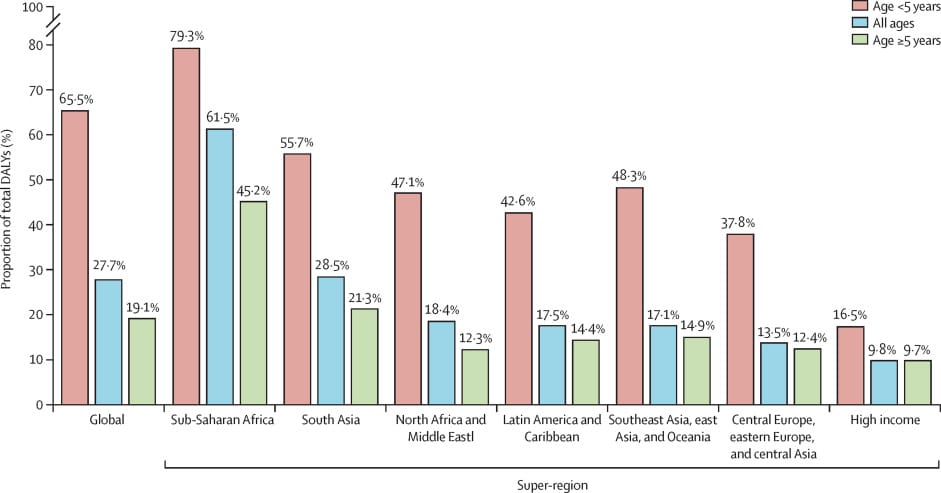
The global burden of disease due to infection
John Rex in his excellent AMR Solutions newsletter highlighted an excellent analysis of the global burden of disease due to infection by Naghavi et al published in The Lancet.
The 'burden' measured in disability-adjusted life-years (DALYs) that are lost due to the disease both from death or incapacitation (years living with a disability).
In 2019 the Global Burden of Disease project estimated that 2.54 billion DALYs were lost due to illnesses of all causes (disease or injury) with 28% of that total being made up by infections. 14% of the total is due to bacterial infections - 352 million DALYs. That is pre-COVID.
To put that into perspective, just 6 bacteria caused almost as much death and disability as tuberculosis, malaria and HIV-AIDS combined (170.8 million DALYs). Those six are Streptococcus pneumoniae (38.1 million DALYs), Staphylococcus aureus (34.5 million), E. coli (31.3 million), Klebsiella pneumoniae (31.1 million), Psuedomonas aeruginosa (18.3 million) and Acinetobacter baumannii (16.7 million)
As Dr Rex points out the "less developed parts of the world bear the greatest load – and children under 5 bear the highest burden no matter where you are in the world."

He also points out the disparity in R&D efforts. Some really interesting stats here:
Head et al. publishing in the Lancet in 2020 found that genital herpes attracted R&D spend in the US equivalent to US$3,101 per DALY between 2000 and 2017 compared with syphilis at only US$9 per DALY despite the latter being responsible for 37.7x more DALYs!
Dr Rex calculates that a similarly lower level of investment was put towards three of the bacteria in the 'top DALYs' list: approximately US$41 per DALY for S. aureus, US$28 for E. coli and US$55 for P. aeruginosa.
Interestingly cancer projects were funded 17x more than antibacterials during 2011-2020.
Antimicrobial Resistance (AMR) is a macro threat to the sustainability of the human race and other species. It is of a similar level to that of the worst impacts of climate change or biodiversity loss and is inextricably linked. Bringing together biological, behavioural, and physical solutions with appropriately incentivising funding we should be able to continue to enjoy the benefits of our microbe partners whilst avoiding their darker side.
AMR is potentially a massive, if complex, theme for those who care about sustainability; the potential goes well beyond the pharmaceutical industry. Here is a primer we wrote a couple of years ago to get you started 👉🏾 https://www.thesustainableinvestor.org.uk/antimicrobial-resistance-a-primer/
(You'll find a bunch of stuff we have written on the topic of AMR on The Sustainable Investor site)
This article featured in What Caught Our Eye, a weekly email featuring stories we found particularly interesting during the week and why. We also give our lateral thought on each one. What Caught our Eye is available to read in full by members.
If you are not a member yet, you can read What Caught Our Eye when it comes out direct in your email inbox plus all of our blogs in full...

Click this link to register 👉🏾 https://www.thesustainableinvestor.org.uk/register/

Please read: important legal stuff.

